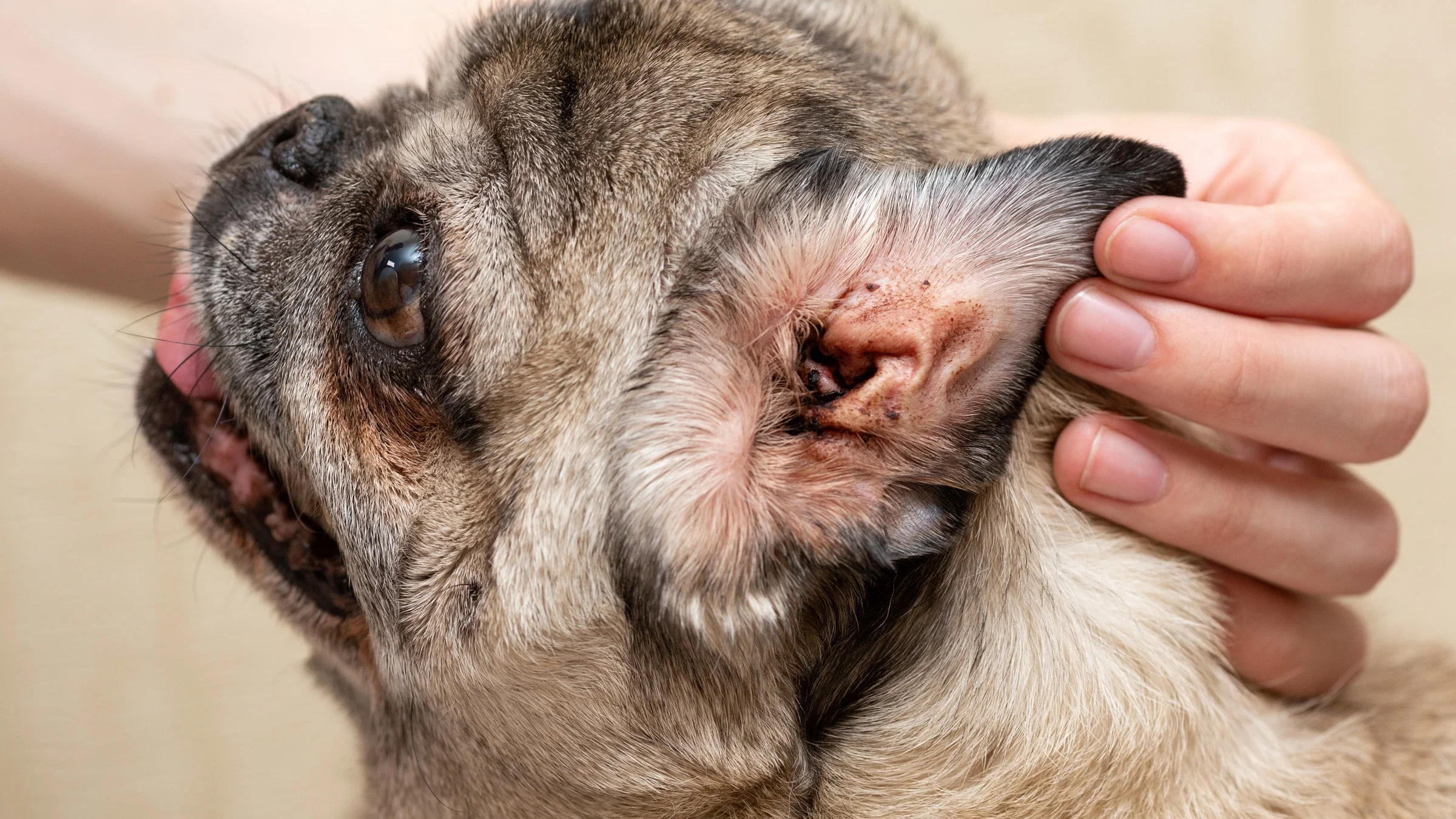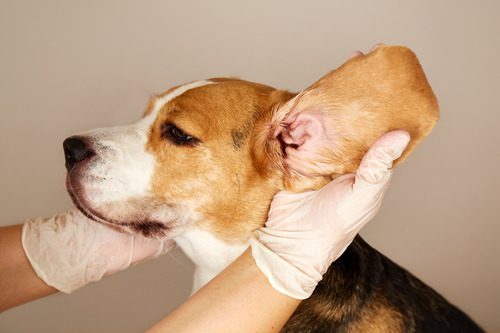Have you ever noticed a strange, unpleasant smell coming from your dog’s ear and wondered what it means? If you have, you’re not alone.
A dog ear infection often brings a distinct odor that can be hard to ignore. Understanding what this smell is like can help you spot an infection early and get your furry friend the care they need. Keep reading, because recognizing this smell might just save your dog from discomfort and serious health issues.

Credit: www.goodrx.com
Common Odors Of Dog Ear Infections
Recognizing the common odors of dog ear infections can help you act quickly and protect your furry friend’s health. The smells often give clear clues about the type and severity of the infection. Paying attention to these scents can make a big difference in catching problems early.
Foul And Musty Smells
A strong, foul odor is one of the most obvious signs of a dog ear infection. It often smells like damp, stale socks or moldy cheese. This smell usually means bacteria have taken hold, creating a thick, unpleasant scent that you won’t miss.
Have you noticed your dog shaking its head more or scratching their ears alongside this smell? These behaviors often go hand in hand with bacterial infections.
Yeasty Or Vinegar-like Scents
A yeast infection in your dog’s ear often produces a scent similar to vinegar or bread dough. This yeasty smell can be subtle at first but tends to get stronger as the infection worsens. It’s caused by an overgrowth of yeast, which thrives in warm, moist environments like your dog’s ear canal.
If you smell this scent, check for redness, swelling, or a waxy discharge. These signs confirm yeast as the likely culprit.
Fishy Or Rotten Odors
Some dog ear infections emit a fishy or rotten smell. This odor can signal a severe infection or ear mites. It’s usually sharp and unpleasant, making it clear something is wrong.
When you detect this smell, your dog might also show signs of pain or discomfort when you touch their ears. Ignoring this could lead to more serious issues, so it’s best to consult your vet promptly.

Credit: www.reddit.com
Causes Behind The Smell
Dog ear infections often come with a noticeable, unpleasant smell. Understanding the causes behind this odor can help in managing and preventing infections. Several factors contribute to the distinctive smell associated with ear infections in dogs.
Bacterial Growth
Bacteria thrive in warm, moist environments. An infected dog’s ear provides the perfect setting. The bacteria multiply quickly, producing by-products that cause a foul smell. This odor is often the first sign of an infection.
Yeast Overgrowth
Yeast infections are common in dogs’ ears. They produce a distinct, musty odor. This smell is often compared to moldy bread or cheese. Yeast thrives in moist environments, making a dog’s ear ideal for growth.
Accumulated Earwax And Debris
Excess earwax and debris can trap moisture and bacteria. This creates a breeding ground for infection. The buildup can lead to an unpleasant smell, signaling a possible infection. Regular cleaning can help reduce this risk.
Signs Accompanying Ear Infections
Ear infections in dogs often come with clear signs that you can spot early. Recognizing these signs helps you act quickly and prevent the problem from worsening. Let’s look at the common symptoms that usually appear alongside ear infections.
Redness And Swelling
One of the first things you might notice is the redness inside your dog’s ear. The skin may look irritated and inflamed, often feeling warm to the touch. Swelling can make the ear flap appear thicker or puffed up, signaling your dog’s body is fighting off infection.
Scratching And Head Shaking
Dogs with ear infections often scratch their ears more than usual. You might see your dog pawing at the ear or rubbing it against furniture. Head shaking is another common sign—your dog tries to relieve discomfort, but this can sometimes make things worse.
Discharge And Crust Formation
Look closely for unusual discharge coming from your dog’s ear. It can be yellow, brown, or even bloody, and may have a foul smell. Over time, this discharge can dry and form crusts around the ear canal, making the area uncomfortable and painful.

Credit: hardypaw.com
Risks Of Ignoring Ear Infection Smells
Ignoring the smell of a dog’s ear infection can lead to serious health problems. That bad odor is a warning sign. Overlooking it can make the infection worse and cause lasting damage. Early attention is key to keeping your dog safe and healthy.
Worsening Infection
An untreated ear infection can quickly get worse. Bacteria or yeast multiply inside the ear. This causes more pain and swelling. The smell grows stronger as the infection spreads deeper. Your dog might scratch and hurt the ear more.
Hearing Loss
Infections can damage the ear canal and eardrum. This damage may lead to hearing problems. Hearing loss can be temporary or permanent. The longer the infection stays, the higher the risk. Protecting your dog’s hearing means acting fast.
Spread To Other Areas
Infections can move beyond the ear. They may reach nearby tissues or the bloodstream. This can cause serious illnesses. The infection might also affect your dog’s balance and coordination. Catching the problem early prevents dangerous spread.
When To Visit The Vet
Knowing when to visit the vet is key to keeping your dog healthy. Ear infections can worsen quickly without care. Early treatment can stop pain and prevent damage.
Watch your dog’s ears closely. Changes in smell, behavior, or appearance can signal problems. Acting fast helps your pet heal faster and feel better.
Persistent Odor
A strong, bad smell from your dog's ear is a warning sign. Normal ears have little to no odor. If the smell lasts more than a day, it may be an infection. Persistent odor means bacteria or yeast could be growing inside.
Behavioral Changes
Your dog may act differently if the ear hurts. Scratching, shaking the head, or rubbing ears on furniture are common signs. They might seem restless or sad. Notice if your dog avoids touch near the ears. These changes show discomfort and need vet care.
Physical Symptoms
Look for redness, swelling, or discharge in the ear. Crusts or scabs can form around the ear flap. The ear may feel warm to touch. Your dog might tilt the head or hold one ear low. These signs point to infection and need a vet’s checkup.
Preventing Dog Ear Infections
Preventing dog ear infections is easier than treating one. If you act early and stay consistent, you can keep your dog’s ears healthy and odor-free. Small habits can make a big difference in avoiding that unpleasant, musty smell that signals an infection.
Regular Ear Cleaning
Cleaning your dog’s ears regularly helps remove dirt, wax, and moisture that bacteria and yeast love. Use a vet-approved ear cleaner and a soft cotton ball—never a cotton swab, as it can push debris deeper.
Try to clean the ears once a week or more if your dog swims or plays outside a lot. Does your dog resist ear cleaning? Make it a positive experience with treats and gentle praise.
Drying Ears After Baths
Water trapped in the ears creates a perfect environment for infections. Always dry your dog’s ears thoroughly after baths or swimming, using a soft towel or ear-drying solution.
Have you noticed your dog shaking its head or scratching after water exposure? That’s your cue to act quickly and keep their ears dry to prevent trouble.
Monitoring For Early Signs
Watch for redness, swelling, or unusual smells coming from your dog’s ears. Early signs can include scratching, head shaking, or your dog tilting its head.
Catch infections before they worsen by checking ears regularly. Would you rather catch a problem early or wait for vet visits and expensive treatments?
Frequently Asked Questions
What Does A Dog Ear Infection Smell Like?
A dog ear infection usually smells foul, musty, or like yeast. It can be similar to a strong, unpleasant odor. This smell results from bacteria or yeast growth inside the ear. Noticing this odor early helps in prompt treatment.
Can A Dog Ear Infection Cause A Bad Odor?
Yes, dog ear infections often cause a bad odor. The smell comes from the buildup of wax, bacteria, or yeast. It can be a sign that your dog needs veterinary care. Ignoring the odor may worsen the infection.
How To Identify A Yeast Smell In Dog Ear Infection?
A yeast smell in dog ear infection is often described as sweet, musty, or like bread. It differs from a foul bacterial odor. This distinct smell can help differentiate between types of infections. Identifying the smell aids in proper treatment.
Does A Dog’s Ear Infection Smell Differ By Infection Type?
Yes, bacterial infections smell foul and rotten, while yeast infections smell sweet or musty. The odor helps in diagnosing the infection type. Recognizing this can guide effective treatment choices for your dog’s ear health.
Conclusion
A dog ear infection often has a strong, unpleasant smell. This smell can be musty, sour, or similar to yeast. It usually means your dog needs care soon. Watch for signs like scratching or redness. Clean your dog’s ears gently and keep them dry.
If the smell stays or gets worse, visit a vet. Treating infections early helps your dog feel better fast. Healthy ears mean a happy dog. Remember, a bad smell is a warning. Act quickly to protect your pet’s health.

Emily Barker is the founder of ChillDogLife.com, a space dedicated to helping pup parents discover the best dog products, lifestyle tips, and cozy ideas for happier homes.
A lifelong dog lover, Emily combines her passion for pets with a knack for research to share trusted recommendations on everything from toys and furniture to health and everyday care.
Her goal is simple: to make life easier, stylish, and more joyful for dogs and the people who love them.







